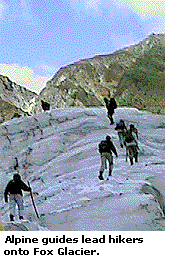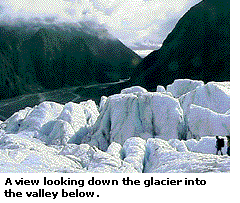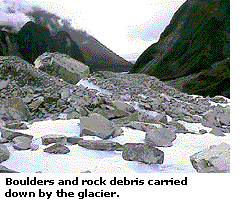 |
My Visits to Fox Glacier and Key Summit |
 |
|||
| Fox Glacier Along the Routeburn Track on South Island, I took a guided tour of the Fox Glacier. We were only 10 miles from the western sea, but ahead I could see Mount Tasman, at 11, 475 feet, topped with snow. Near the snout of the glacier, 10 keas, the native alpine parrots, were pulling pieces of rubber trim from a parked car. We climbed past signs warning of falling rocks and floods, then worked our way up onto the glacier, a folded and cracked mass of ice. Guides cut steps with ice axes, so we could advance across deep cracks called crevasses. We wore spikes called crampons on our boots, which also had iron hobnails on their soles. We carried spiked-sticks called alpenstocks, which helped us balance as we moved over the slippery ice. Fox Glacier is still growing. Near Mount Tasman, 80 to 100 meters of snowfall a year piles up at the top of the glacier. The weight of the packed snow and ice pushes the ice down the valley at the rate of about 1 meter a day. As the ice moves, it carries huge boulders and small pieces of rock down into the valley below. The glacier shapes the land as it moves — this erosion is a powerful thing to see. As the mountains are being pushed up by colliding tectonic plates, they are also being cracked apart by the action of the glaciers. Fox Glacier is unusual in that it comes down from mountains right into coastal rainforest. Rivers coming out of the mountains here are a pale blue-green color. The water also looks milky, since it carries ground rock, or "rock flour." Here, just as with places with volcanoes and earthquakes, you can see that the Earth is an amazing, living, constantly changing place. Key Summit On the summit were white gentian flowers, little red sundews, with sticky dewdrops hanging from their leaves, small white daisy-like flowers, and a tiny blue flower with yellow in the center, like a five-petalled star. A giant black and yellow dragonfly, four inches long, sat basking in the sun. In a sheltered grove of taller trees, beard moss hung from branches and other epiphytes clung to the trees. This place had once lain under 500 meters of ice, but it was now covered with living things, specially adapted to survive the cold, wind, sun, and other harsh conditions of the mountains. There is lichen, which can survive in temperatures as low as minus 70 degrees centigrade. There are also unusual small alpine plants, such as bladderworts and sundews that trap and digest insects to gain extra nutrients. The trees here are silver beech, stunted by the cold and angled by the prevalent wind. Some trees are hundreds of years old, but are only a few feet high. . |

|
||||



